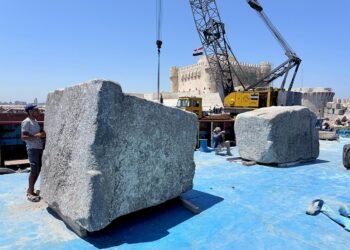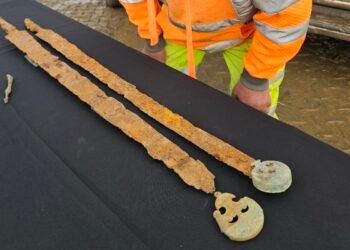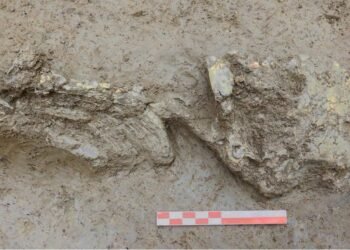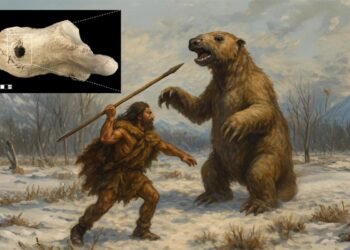Archaeologists from Mexico’s National Institute of Anthropology and History (INAH) have discovered a monumental stone panel inscribed with an extensive Mayan hieroglyphic text in the Cobá Archaeological Zone, located in Quintana Roo. This panel was found carved into the rock of a sacred pool near the towering Nohoch Mul pyramid.

Cobá, a city that flourished between 100 BCE and CE 1200, was once a major political and cultural hub in the Yucatán Peninsula. At its peak, the city was home to an estimated 50,000 inhabitants, with much of its construction occurring during the Middle and Late Classic periods (CE 500-900). The site is renowned for its well-preserved structures, including Nohoch Mul, the tallest pyramid in the region.
The newly discovered panel is a remarkable find, consisting of 123 hieroglyphic cartouches arranged in an L-shaped formation. Covering an area of over 11 square meters, this intricate inscription provides valuable information about Cobá’s dynastic history. According to a preliminary epigraphic analysis, the glyphs reveal the founding of a settlement called Keh Witz Nal, or “Mountain of the Deer,” on May 12, CE 569. This discovery is crucial in filling gaps in the historical record of Cobá’s rulers, including the identification of a previously unknown sovereign named K’awiil Ch’ak Chéen.
Diego Prieto Hernández, the General Director of INAH said that this discovery confirms the significance of Cobá as a major city-state in the ancient Maya world. The panel also indicates that many of Cobá’s rulers adopted the name of the god K’awil, believed to grant them divine attributes as protectors of the city. “This connection between historical events and mythical origins is reflected in the panel, which alludes to tutelary gods such as Bolón Tz’akab Ajaw, the ‘Lord of Countless Generations,’ responsible for the foundation of the maize and cacao dynasties,” Prieto Hernández explained.
The panel’s discovery was part of the broader Archaeological Zones Improvement Program (Promeza), which aims to protect and study the region’s archaeological heritage. Extensive conservation efforts have been undertaken to preserve the panel, which has suffered from erosion due to environmental factors.
Restoration work on the panel has included the careful cleaning of soil, salts, and vegetation that covered it, as well as the injection of lime mortar fillers to strengthen the rock’s internal structure. In addition, high-precision recordings of the glyphic text have been made using state-of-the-art technology, creating 3D models that will facilitate further epigraphic studies and the eventual complete deciphering of the text.
Prieto Hernández highlighted that similar efforts under Promeza are underway at other archaeological sites along the eastern coast of Quintana Roo, such as El Meco, Tulum, and Muyil. These initiatives aim to uncover and preserve the rich history of the Maya civilization while making these sites more accessible and informative to the public.
In particular, the Museum of the Eastern Coast, set to open in Tulum in September 2024, will showcase artifacts recovered during Promeza’s work.
More information: INAH
























